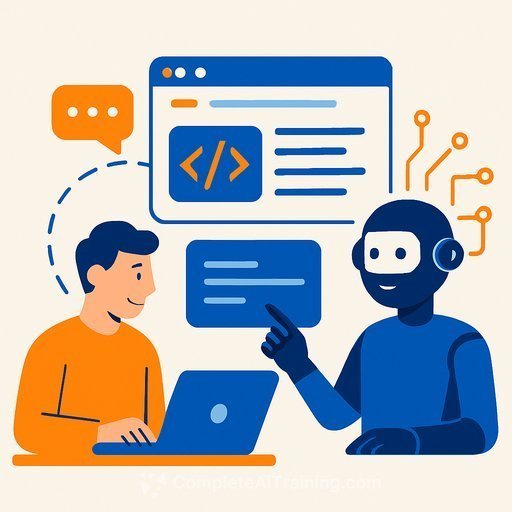AI In Software Development: From Helper To Teammate
AI has moved from novelty to necessity in engineering teams. It writes boilerplate, flags bugs, and supports decisions so humans can focus on problems that move the business. With agentic systems maturing and computing capacity surging, use cases are expanding into cybersecurity, logistics, and ops.
This shift isn't just automation. It's a role change: systems handle repetitive tasks while developers focus on architecture, product thinking, and reliability.
Build A Collaborative Workflow With AI
Treat AI like a pair programmer, not a vending machine. Start with coding assistants that generate snippets, refactor, and explain errors. Tools such as GitHub Copilot are becoming baseline in many stacks, and industry reports show measurable gains in throughput and cycle time.
- Standardize prompts for common tasks (tests, CRUD, docs). Store them with your repo.
- Pair AI output with unit tests and linters to keep quality high.
- Set guardrails: no secrets in prompts, approved model list, code scanning before merge.
- Review AI-generated changes like you would a junior engineer's PR-fast feedback, clear standards.
GitHub Copilot is a practical starting point for most teams. Track impact with basic metrics: lead time, PR review time, escaped defects.
Move Up The Stack: Where Your Time Pays Off
As routine coding shifts to AI, invest your time in architecture, reliability, and product outcomes. Automate testing and deployment so you can focus on UX, data flows, and integration points that affect customer value.
- Define service boundaries, SLAs/SLOs, and observability from day one.
- Use AI to write tests and generate fixtures; you own coverage strategy and edge cases.
- Let AI draft docs; you refine the mental model and tradeoffs.
- Push toward platform thinking: reusable modules, golden paths, and paved roads.
Multimodal And Agentic Systems: From Prototype To Production
Multimodal models (text, images, video) and agentic flows unlock new interfaces and automations. Think triaging security events, routing logistics, or assisting analysts with context-rich actions.
- Start with small loops: tool use, retries, and guardrails in a sandboxed environment.
- Instrument everything-latency, token usage, success/failure reasons, and human override rates.
- Stage rollouts: internal pilots, canary users, then production with kill switches.
Ethics, Security, And Governance Aren't Optional
Bias, privacy, and model risk need explicit handling. Explainable approaches help teams validate decisions, especially in finance and healthcare. Security threats are evolving alongside AI, so protect data flows and model interfaces.
- Adopt data minimization: redact PII before prompts; isolate secrets and keys.
- Use policy checks: allowed tools, approved models, and audit trails for prompts/responses.
- Threat model LLM features: prompt injection, over-permissioned tools, data exfiltration.
- Add human-in-the-loop for high-impact actions and maintain clear rollback plans.
On-Prem And Open Source For Cost And Control
On-prem or VPC-hosted models cut inference costs, reduce latency, and keep data within your boundary. Fine-tuned open-source models are viable for narrow tasks and can outperform larger general models on those lanes.
- Start with a reference stack: containerized serving, vector DB, and a prompt router.
- Benchmark against your tasks, not general leaderboards. Measure accuracy, drift, and total cost.
- Plan model updates like dependencies: semantic versioning, rollbacks, and regression tests.
Keep Learning Or Fall Behind
Markets are expanding as AI and cloud adoption accelerate, and companies want sustainable, governance-first AI. Expect more no-code orchestration and hyper-automation across back-office and ops. Continuous upskilling is the moat.
- Set quarterly learning goals: one AI tool, one security practice, one data skill.
- Build small internal playbooks (prompt patterns, eval templates, incident runbooks).
- Share wins and failures in brown-bags to raise the team's baseline.
For structured upskilling on AI for developers, explore focused training and certifications at Complete AI Training - Courses by Job or the AI Certification for Coding.
Practical Starter Checklist
- Pick one assistant (e.g., Copilot) and define usage rules.
- Create a prompt repo for tests, refactors, and docs. Version it.
- Add AI quality gates: static analysis, unit tests, and evals before merge.
- Prototype one agentic workflow with strict scopes and metrics.
- Draft a lightweight AI policy: data handling, model approvals, and audit logs.
- Review quarterly: costs, latency, accuracy, and developer experience.
AI won't replace developers who think clearly and ship well. It will amplify teams that systematize their process, measure results, and keep learning.
Your membership also unlocks:






